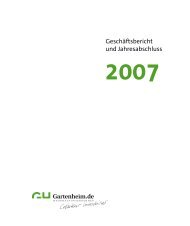analysis of the influences of solar radiation and façade glazing ...
analysis of the influences of solar radiation and façade glazing ...
analysis of the influences of solar radiation and façade glazing ...
You also want an ePaper? Increase the reach of your titles
YUMPU automatically turns print PDFs into web optimized ePapers that Google loves.
1.2 Background <strong>and</strong> literature review 17<br />
used in both sensitivity studies <strong>of</strong> dynamic systems <strong>and</strong> in building optimization problems<br />
with a large number <strong>of</strong> combination tests.<br />
Building structures <strong>and</strong> environments are modeled by a system <strong>of</strong> differential algebraic<br />
equations. Required smoothness assumptions that can be applied in <strong>the</strong> solution <strong>of</strong> <strong>the</strong>se<br />
types <strong>of</strong> equation sets have been proposed by Wetter (Wetter, 2005). A new multi-zone<br />
building energy simulation program called BuildOpt, which differs from o<strong>the</strong>r s<strong>of</strong>tware<br />
because <strong>of</strong> <strong>the</strong> inclusion <strong>of</strong> various smoothing algorithms, was presented. The numerical<br />
experiments indicated a reduction in <strong>the</strong> computation time <strong>and</strong> a high precision <strong>of</strong><br />
smoothing techniques proposed by <strong>the</strong> author.<br />
Multi-objective genetic algorithm (MOGA) was used by Wright (Wright, et al., 2002) to<br />
estimate <strong>the</strong> optimum pay-<strong>of</strong>f characteristic between daily energy costs <strong>and</strong> <strong>the</strong> quality <strong>of</strong><br />
<strong>the</strong> <strong>the</strong>rmal environment in <strong>the</strong> building. An example <strong>of</strong> a single zone HVAC system<br />
composed <strong>of</strong> cooling <strong>and</strong> heating coils, a regenerative heat exchanger <strong>and</strong> a supply fan was<br />
used to show <strong>the</strong> benefits <strong>of</strong> <strong>the</strong> multi-criterion optimization genetic algorithm. Estimates<br />
indicated that MOGA search methods can be successfully used in <strong>the</strong> <strong>the</strong>rmal design <strong>of</strong><br />
buildings in respect to occupant comfort.<br />
Genetic algorithms were used by Xu <strong>and</strong> Wang (Xu, et al., 2007) in <strong>the</strong> <strong>the</strong>rmal modelling<br />
<strong>of</strong> <strong>the</strong> building envelope. They developed a method to optimize <strong>the</strong> parameters <strong>of</strong> <strong>the</strong><br />
simplified dynamic model based on frequency domain regression. Validation <strong>of</strong> <strong>the</strong><br />
optimization method <strong>and</strong> its effectiveness were conducted by comparing <strong>the</strong> predictions<br />
with <strong>the</strong> results from <strong>the</strong> <strong>the</strong>oretical model. It was found that <strong>the</strong> frequency domain<br />
<strong>analysis</strong> greatly simplified <strong>the</strong> search for optimal parameters.<br />
Earth-contact heat transfers in built environments were investigated by Davies <strong>and</strong><br />
colleagues (Davies, et al., 2001). They improved <strong>the</strong> efficiency <strong>of</strong> <strong>the</strong> numerical technique<br />
by adopting some elements from <strong>the</strong> response factor method. The results <strong>of</strong> calculations<br />
based on <strong>the</strong> new model showed a dramatic decrease in <strong>the</strong> computing time <strong>of</strong> <strong>the</strong><br />
simulations compared to <strong>the</strong> traditional finite volume technique in keeping with accuracy<br />
<strong>and</strong> flexibility.<br />
The accuracy <strong>of</strong> <strong>the</strong> building energy simulations strongly depends on <strong>the</strong> estimate <strong>of</strong> <strong>solar</strong><br />
irradiance on external facades. Loutzenhiser, along with co-workers (Loutzenhiser, et al.,<br />
2007), validated short-wave <strong>radiation</strong> in <strong>solar</strong> gain models applied in energy simulation<br />
s<strong>of</strong>tware. In <strong>the</strong> experiment, a database <strong>of</strong> <strong>solar</strong> <strong>radiation</strong> from two 25-day measurements<br />
performed on <strong>the</strong> EMPA campus located in Duebendorf (Switzerl<strong>and</strong>) was used.<br />
Calculations were made using four building energy simulation programs: EnergyPlus,<br />
DOE-2.1e, ESP-r <strong>and</strong> TRNSYS-TUD <strong>and</strong> seven <strong>solar</strong> <strong>radiation</strong> models. Using <strong>the</strong> mean<br />
absolute differences method, it verified that <strong>the</strong> uncertainties <strong>of</strong> <strong>the</strong> models are as follows:<br />
14.9 % for <strong>the</strong> isotropic sky, 9.1 % for <strong>the</strong> Hay–Davies, 9.4 % for <strong>the</strong> Reindl, 7.6 % for <strong>the</strong><br />
Muneer, 13.2 % for <strong>the</strong> Klucher, 9.0 % for <strong>the</strong> modified Perez <strong>and</strong> 7.9 % for Perez.





